Uruguay is at the forefront of sustainable architecture and eco-friendly practices with its top green buildings. These structures showcase a commitment to energy-efficient construction, the use of sustainable building materials, and adherence to green building practices. Many of them have received LEED certification, further highlighting Uruguay’s dedication to creating a sustainable infrastructure.
Key Takeaways:
- Uruguay is a leader in sustainable architecture and green building design.
- The country embraces eco-friendly practices, such as energy-efficient construction and the use of sustainable building materials.
- Many of Uruguay’s top green buildings have achieved LEED certification.
- The focus on sustainable infrastructure showcases Uruguay’s commitment to a greener future.
- Uruguay’s top green buildings serve as inspiring examples for sustainable development worldwide.
MVRDV’s Residential Building “Ziel” in Montevideo
MVRDV, the esteemed architecture firm known for its innovative designs, has recently unveiled their latest creation in Montevideo, Uruguay. The Ziel residential building stands tall at 15 stories and sets a new standard for sustainable architecture in the city.
The centerpiece of Ziel’s design philosophy is creating an open and permeable environment that seamlessly merges with its surroundings. The building’s layout allows for ample natural light and fresh air to flow through, providing a refreshing and rejuvenating atmosphere for the residents.
One of the standout features of Ziel is its incorporation of lush green spaces within the building. The architects have strategically placed verdant courtyards throughout the structure, creating serene and inviting pockets of nature. These green spaces not only enhance the overall aesthetics but also contribute to the well-being of the residents by promoting a connection with nature.
To showcase the commitment to sustainability, Ziel emphasizes the use of eco-friendly materials and energy-efficient strategies. The design integrates sustainable building practices to minimize the environmental impact, ensuring a greener future for Montevideo.
Take a moment to visualize Ziel’s remarkable design:
Features of MVRDV’s Ziel Residential Building
| Features |
Description |
| Open and permeable environment |
The building allows light and air to flow through, creating a refreshing atmosphere. |
| Green spaces |
Strategically placed courtyards with lush vegetation connect residents with nature. |
| Eco-friendly materials |
The use of sustainable building materials reduces environmental impact. |
| Energy-efficient strategies |
The design incorporates energy-saving technologies for a greener future. |
With Ziel, MVRDV has succeeded in creating a residential building that not only embraces sustainable architecture but also provides a harmonious living experience within an open and green environment. Montevideo’s skyline has been forever transformed by this remarkable addition, showcasing the city’s dedication to sustainable development.
Facilities and Sustainability Features of Ziel
Ziel, the impressive residential building designed by MVRDV, offers a myriad of facilities and sustainability features for its fortunate residents. The meticulous design and meticulous attention to detail of Ziel ensure a luxurious and sustainable living experience.
One of the standout features of Ziel is its rooftop terrace, providing a serene oasis for residents to unwind and enjoy breathtaking views of the surrounding cityscape. The terrace encompasses a stylish lounge area and a dining room, perfect for hosting intimate gatherings or simply savoring quiet moments in the open air.
The rooftop terrace also boasts a stunning swimming pool, inviting residents to take a refreshing dip while relishing the panoramic vistas. Surrounding the pool are lush gardens, creating a serene and green retreat amidst the urban landscape.
In addition to the rooftop amenities, Ziel offers exceptional fitness and wellness facilities. The lower levels of the building house a state-of-the-art gym, equipped with modern exercise equipment to cater to various fitness needs. Residents can also indulge in pampering sessions at the spa, providing a range of rejuvenating treatments and therapies.
Furthermore, Ziel’s commitment to sustainability is exemplified by its LEED-Platinum certification. The building incorporates sustainable features, including solar panels on the roof, harnessing renewable energy to power the facilities and reduce environmental impact.
To further illustrate the facilities and sustainability features of Ziel, below is a detailed table:
| Facilities |
Description |
| Rooftop Terrace |
A serene outdoor space with a lounge, dining room, swimming pool, and gardens. |
| Gym |
A state-of-the-art fitness center with modern workout equipment. |
| Spa |
A wellness haven offering a range of rejuvenating treatments and therapies. |
Ziel’s aim to provide a sustainable and eco-friendly living experience is evident in every aspect of its design. Residents can luxuriate in the amenities and embrace a greener lifestyle, supported by Ziel’s commitment to sustainability.
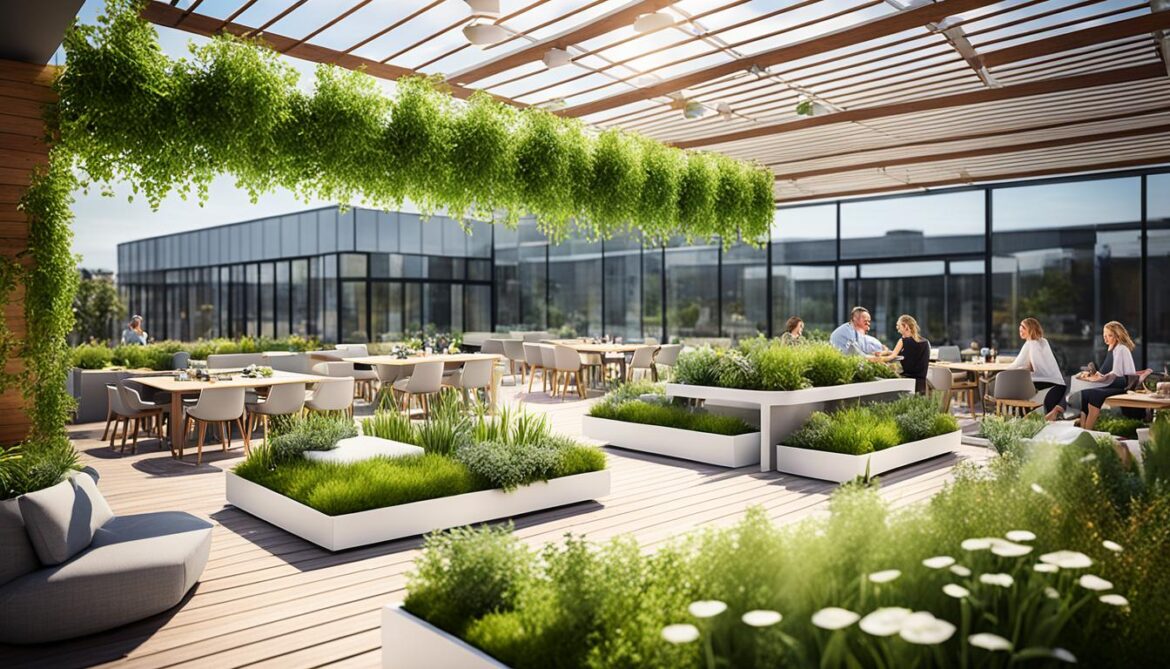
Uruguay’s Embrace of Wood in Construction
Uruguay has embraced wood construction as a cornerstone of sustainable architecture, recognizing its role in promoting renewable energy and eco-friendly practices. With a thriving forestry industry and a steadfast commitment to sustainable materials, Uruguay is at the forefront of timber production and construction innovation.
The Importance of the Forestry Industry
The forestry industry in Uruguay has experienced significant growth over the past three decades, resulting in an increase in forest areas. This expansion has paved the way for the sustainable production of wood materials, creating a positive impact on the environment and renewable energy efforts.
Uruguay’s focus on sustainable timber production revolves around two key tree species: Pinus and Eucalyptus. These varieties are highly suitable for both structural use and carpentry applications, making them ideal choices for various construction projects.
CLT Panels and Glue Laminated Timber
To further accentuate its commitment to wood construction, Uruguay has showcased the structural feasibility and versatility of Pinus and Eucalyptus through the use of Cross-Laminated Timber (CLT) panels and Glue Laminated Timber. These innovative construction materials are revolutionizing the industry by providing sustainable alternatives to traditional building materials.
CLT panels consist of layers of wood boards placed at right angles and glued together, creating a strong, durable, and sustainable building solution. Glue Laminated Timber, on the other hand, utilizes glued layers of wood beams to enhance structural integrity and promote longevity.
By embracing CLT panels and Glue Laminated Timber, Uruguay not only demonstrates its dedication to sustainable construction but also enhances the visual appeal and functionality of its buildings.
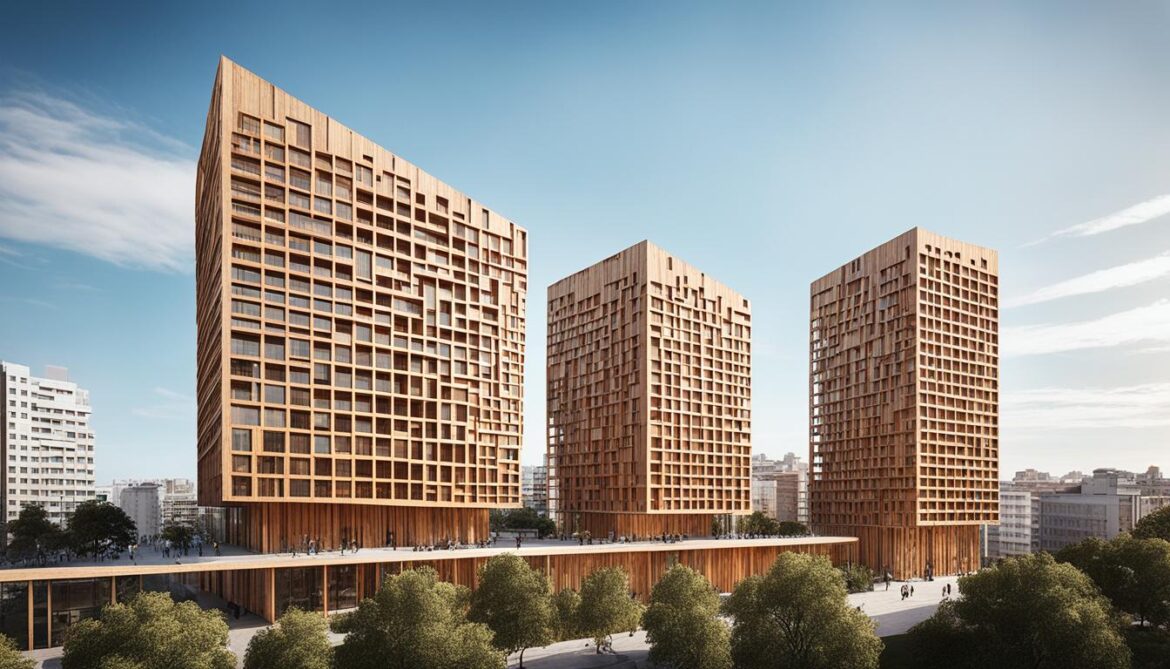
Uruguay’s embrace of wood in construction underscores its commitment to sustainable materials, renewable energy, and a greener future. The use of Pinus and Eucalyptus species, combined with innovative construction techniques like CLT panels and Glue Laminated Timber, enables Uruguay to showcase its leadership in sustainable architecture and eco-friendly practices.
IDB’s Call for Wood-Based Social Housing Design
The Inter-American Development Bank (IDB) and the Government of Uruguay are inviting contributions from companies and professionals to design wood-based social housing. This collaborative initiative aims to promote green construction systems and innovative sustainable architectural solutions. By encouraging the production of housing built with wood, Uruguay aims to reduce the carbon footprint and mitigate climate change.
| Benefits of Wood-Based Social Housing |
Importance of Green Construction Systems |
Sustainable Architectural Solutions |
- Enhanced energy efficiency
- Reduced environmental impact
- Lower carbon emissions
- Improved indoor air quality
|
- Promotes sustainable practices
- Conserves natural resources
- Minimizes waste
- Supports renewable materials
|
- Incorporation of passive design strategies
- Integration of green spaces
- Efficient use of natural light
- Utilization of eco-friendly materials
|
| Wood-based social housing offers a range of benefits, including enhanced energy efficiency and reduced environmental impact. Green construction systems play a vital role in promoting sustainable practices, conserving natural resources, and minimizing waste. By embracing sustainable architectural solutions, Uruguay can create housing that incorporates passive design strategies, integrates green spaces, utilizes natural light efficiently, and employs eco-friendly materials. |
By encouraging the use of wood in social housing projects, Uruguay envisions a sustainable future built on eco-friendly practices. The IDB’s call for wood-based social housing design highlights Uruguay’s commitment to green construction systems and showcases the country’s determination to adopt sustainable architectural solutions. Through this collaboration, Uruguay aims to inspire innovative designs that uphold environmental responsibility and contribute to a more sustainable and resilient built environment.
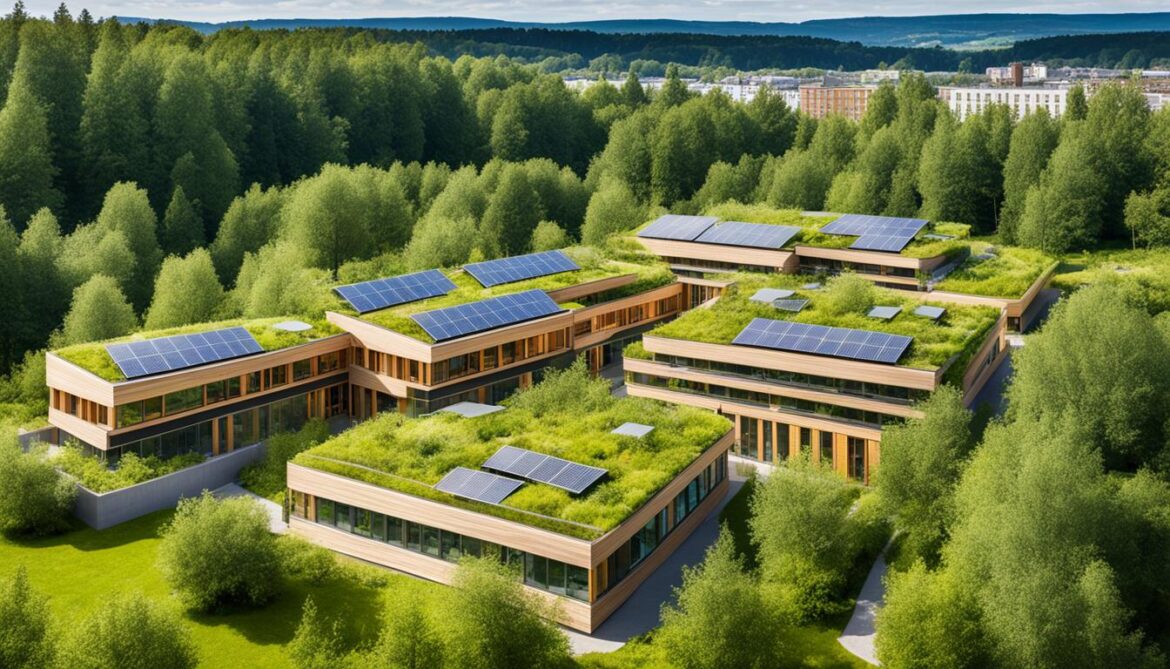
Uruguay’s Renewable Energy Achievements
Uruguay is globally recognized for its achievements in renewable energy development. The country has undergone a significant shift from petroleum-based electricity generation to renewable sources. It currently generates over 98% of all electricity from renewable sources, primarily wind and hydropower. Uruguay’s commitment to decarbonization and sustainable energy generation has positioned it as a leader in the global transition towards a greener future.
Transition to Renewable Energy
Uruguay’s transition to renewable energy sources has been a remarkable success story. The country has harnessed its abundant natural resources, such as strong winds and rivers, to become a powerhouse in renewable energy generation. This shift has not only reduced greenhouse gas emissions but has also reduced the country’s dependence on imported fossil fuels, improving energy security and promoting energy independence.
Wind and Hydropower
Wind and hydropower are the two main pillars of Uruguay’s renewable energy sector. The country’s favorable geographical location and strong winds have made wind power a major contributor to its electricity generation. Additionally, Uruguay has tapped into its vast network of rivers and dams to harness hydropower, further diversifying its renewable energy portfolio. Together, wind and hydropower account for the majority of Uruguay’s electricity generation, making it a global leader in these sectors.
Exploring New Horizons
Building on its success with wind and hydropower, Uruguay is now looking to explore new opportunities in the renewable energy landscape. The country has set its sights on becoming a pioneer in green hydrogen production, a potentially game-changing energy source. Green hydrogen, produced through renewable energy-powered electrolysis, has the potential to revolutionize various sectors, including transportation, industry, and energy storage.
In addition to green hydrogen, Uruguay is also exploring the use of e-fuels as an alternative to fossil fuels. E-fuels, synthesized from renewable energy sources, offer a way to decarbonize transportation and reduce emissions from sectors that are hard to electrify. Uruguay’s forward-thinking approach to energy innovation positions it at the forefront of these emerging technologies.
Energy Efficiency and Electric Transportation
Uruguay recognizes that achieving a sustainable future goes beyond renewable energy generation. Energy efficiency plays a crucial role in reducing overall energy demand and ensuring the responsible use of resources. The country has implemented various initiatives to promote energy efficiency in buildings, industries, and transportation.
Furthermore, Uruguay is actively promoting electric transportation to reduce emissions from the transportation sector. The government has introduced incentives and infrastructure development plans to encourage the adoption of electric vehicles. This transition to electric transportation aligns with Uruguay’s renewable energy goals and further contributes to its decarbonization efforts.
With its remarkable achievements in renewable energy, commitment to decarbonization, and efforts to promote energy efficiency and electric transportation, Uruguay serves as a shining example of how countries can transition to a sustainable and clean energy future.
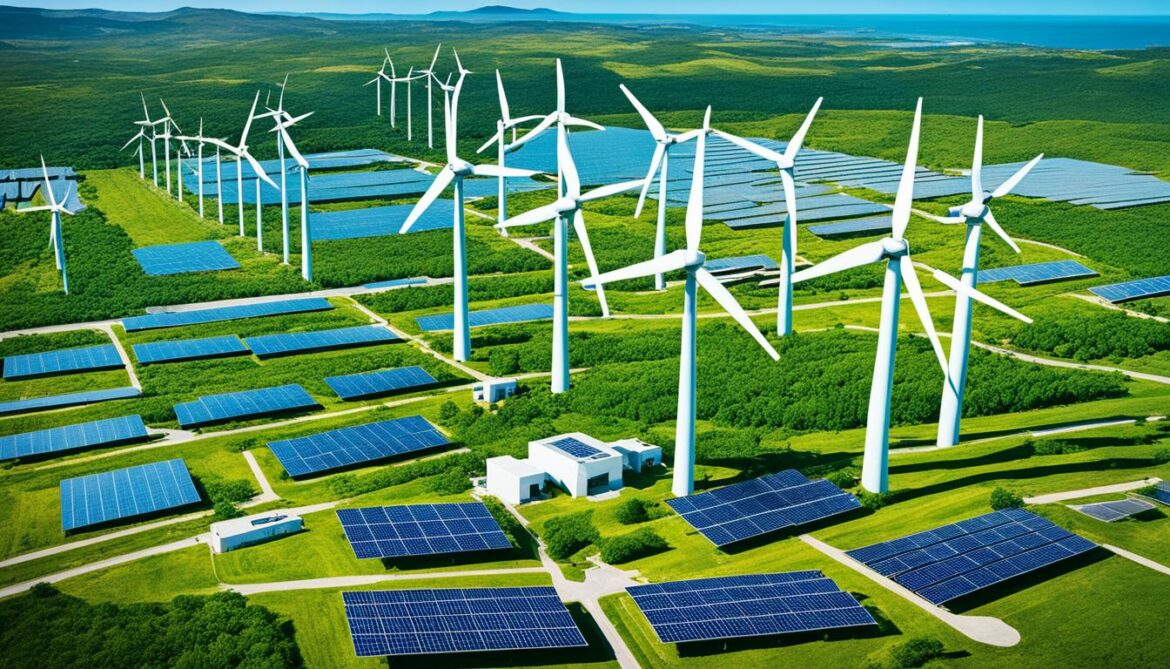
Opportunities in Uruguay’s Energy Sector
Uruguay’s transition to renewable energy presents numerous opportunities in the energy sector. As the country embraces sustainable practices, there is a growing demand for investment and innovation in power generation to meet the increasing energy demand.
The government is actively encouraging the production of green hydrogen, aiming to position Uruguay as a major player in the global green hydrogen market. Projects related to hydrogen production offer exciting prospects for those interested in contributing to the development of this emerging sector.
Additionally, power grid upgrade initiatives in Uruguay are creating opportunities in transmission and smart grid technologies. These advancements are crucial for efficiently integrating renewable energy sources into the power grid and ensuring a reliable and resilient energy infrastructure.
Battery storage is another area that presents significant opportunities. As the penetration of renewable energy sources increases, the ability to store excess energy becomes crucial for grid stability. Investing in battery storage technology and infrastructure can help address the intermittency of renewable energy and provide backup power during peak demand.
By capitalizing on these opportunities in power generation, hydrogen production, power grid upgrade, transmission, smart grid technologies, and battery storage, investors and industry players can contribute to Uruguay’s sustainable energy future while benefitting from the growth potential of the sector.
While Uruguay has made substantial progress in renewable energy adoption, there is still a need for expertise, technology, and investment to maximize the country’s renewable energy potential. Collaboration between local and international stakeholders is vital to drive further advancements in the energy sector.
| Opportunities in Uruguay’s Energy Sector |
Benefits |
| Power Generation |
– Meeting the increasing energy demand
– Expanding renewable energy capacity |
| Hydrogen Production |
– Contributing to Uruguay’s green hydrogen strategy
– Tapping into the global green hydrogen market |
| Power Grid Upgrade |
– Creating a more efficient and resilient energy infrastructure
– Integrating renewable energy sources seamlessly |
| Transmission and Smart Grid Technologies |
– Enhancing energy transmission efficiency
– Enabling smart grid functionalities for optimized energy management |
| Battery Storage |
– Facilitating the integration of renewable energy
– Providing backup power and grid stability |
By capitalizing on these opportunities, Uruguay can continue to lead the way in renewable energy adoption and contribute to a sustainable future.
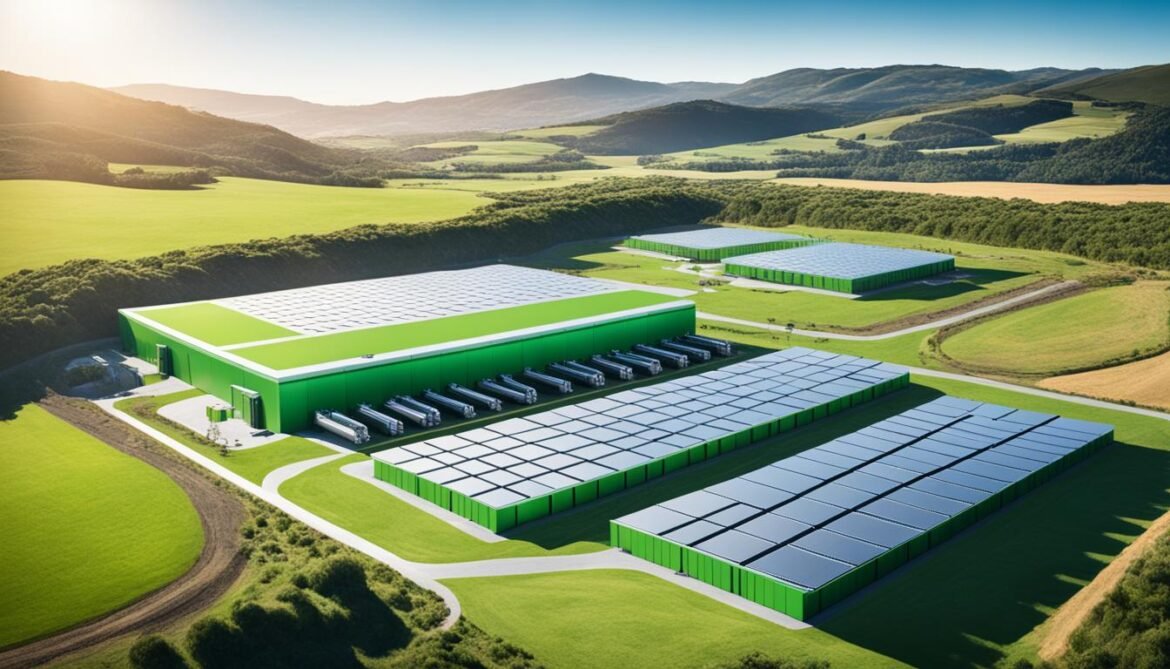
Incentives for Renewable Energy in Uruguay
The government of Uruguay has implemented incentive plans to promote the use of renewable energies in various sectors. Companies investing in energy generation, energy efficiency, and the transition to electric vehicle fleets can benefit from tax incentives. Additionally, the importation of electric vehicles, renewable energy generators, and capital equipment is duty-free. Uruguay is actively supporting the adoption of renewable energy and electric transportation.
Renewable energy incentives play a vital role in Uruguay’s commitment to a sustainable future. These incentives aim to incentivize businesses and individuals to invest in renewable energy technologies and practices, thereby reducing carbon emissions and promoting clean energy sources.
One of the key incentives for the renewable energy industry in Uruguay is the tax incentive scheme. Companies engaged in energy generation from renewable sources, such as wind, solar, and hydroelectric power, can benefit from tax breaks and exemptions. This includes reduced corporate tax rates, tax credits for renewable energy investments, and accelerated depreciation for renewable energy equipment.
Furthermore, companies that prioritize energy efficiency can also avail themselves of tax incentives. By implementing energy-efficient measures in their operations and buildings, businesses can reduce their energy consumption and carbon footprint. In return, they can enjoy tax benefits that lower their overall tax liabilities and promote sustainable practices.
The transition to electric vehicles (EVs) is another area that Uruguay is prioritizing. To encourage the adoption of EVs and support the development of charging infrastructure, the government provides tax incentives for companies transitioning their vehicle fleets to electric alternatives. This includes tax exemptions and reductions on imported EVs and charging equipment, along with other financial incentives.
Moreover, Uruguay offers duty-free imports on electric vehicles, renewable energy generators, and capital equipment related to the renewable energy industry. This makes it more cost-effective for businesses and individuals to access and deploy clean energy technologies, thus accelerating the nation’s transition to renewable energy sources.
Overview of Renewable Energy Incentives in Uruguay
| Incentive |
Description |
| Tax Incentives |
Reduced corporate tax rates, tax credits, accelerated depreciation for renewable energy investments. |
| Energy Efficiency Incentives |
Tax benefits for implementing energy-saving measures in buildings and operations. |
| Electric Vehicle Incentives |
Tax exemptions and reductions on imported EVs and charging equipment for companies transitioning their fleets to electric vehicles. |
| Duty-Free Imports |
No custom duties on electric vehicles, renewable energy generators, and capital equipment related to the renewable energy industry. |
The combination of tax incentives, duty-free imports, and support for electric transportation demonstrates Uruguay’s commitment to a sustainable future. These measures encourage the growth of the renewable energy industry, stimulate investment, and advance the transition to a cleaner and more energy-efficient society.

Leading Sub-Sectors in Uruguay’s Renewable Energy Industry
Uruguay’s renewable energy industry is flourishing, with several key sub-sectors driving its growth. The country has implemented a comprehensive green hydrogen strategy, highlighting its commitment to the production and utilization of green hydrogen. Alongside this, Uruguay possesses a robust capacity for hydroelectric power generation and is recognized globally for its leadership in wind power production. Solar energy is also on the rise, gaining momentum as a viable renewable energy source. Additionally, biomass plays a significant role in Uruguay’s energy supply, further diversifying its renewable energy portfolio.
These sub-sectors present lucrative opportunities for investment and development, contributing to Uruguay’s sustainable energy future.
“Uruguay’s commitment to renewable energy sub-sectors such as hydrogen, hydroelectric, wind, solar, and biomass showcases its dedication to a greener future.”
For a comprehensive overview of Uruguay’s renewable energy industry, refer to the table below:
| Renewable Energy Sub-Sectors |
Key Features and Contributions |
| Hydrogen |
Promotion of green hydrogen production and usage |
| Hydroelectric |
Strong capacity for hydroelectric power generation |
| Wind |
Global leader in wind power production |
| Solar |
Increasing momentum as a renewable energy source |
| Biomass |
Significant contribution to Uruguay’s energy supply |
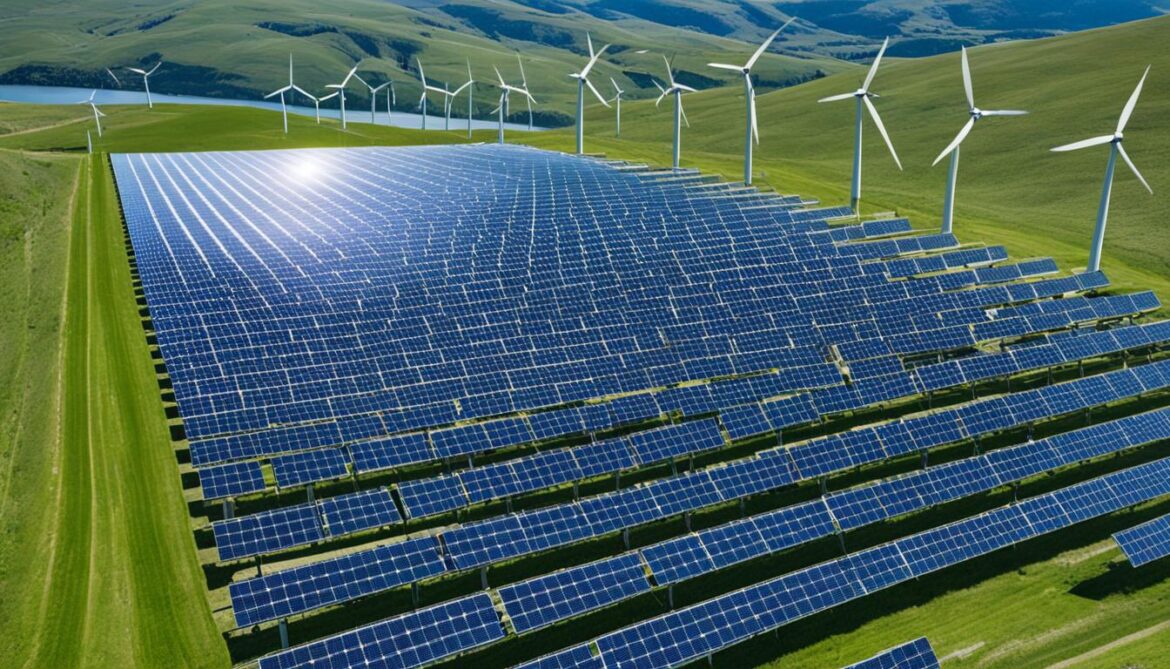
Conclusion
Uruguay’s dedication to sustainable architecture, renewable energy, and green construction is paving the way for a sustainable future. The country’s top green buildings, along with initiatives like wood-based social housing and green hydrogen projects, showcase Uruguay’s commitment to eco-friendly practices and sustainable infrastructure.
By embracing renewable energy sources and promoting green construction methods, Uruguay is positioning itself as a leader in sustainable development. The country’s focus on energy efficiency, the use of sustainable materials, and adherence to green building practices sets a positive example for other nations striving for a greener future.
With its top green buildings and ongoing efforts to prioritize renewable energy, Uruguay is demonstrating its commitment to creating a sustainable and eco-friendly environment for both present and future generations. By embracing these practices, Uruguay is taking significant strides towards achieving a sustainable future and setting an example for other countries around the world.
FAQ
What are the key features of Uruguay’s top green buildings?
Uruguay’s top green buildings are designed with a focus on energy efficiency, the use of sustainable building materials, and adherence to green building practices. Many of these buildings are LEED certified, showcasing Uruguay’s commitment to sustainable infrastructure.
What is the design concept behind MVRDV’s residential building “Ziel” in Montevideo?
MVRDV’s residential building “Ziel” in Montevideo features an open and permeable environment that allows light and air to flow through the structure. The design incorporates green spaces and a courtyard to ensure ample natural light and vegetation throughout the building.
What facilities are available in Ziel and what sustainability features does it have?
Ziel offers a range of facilities for its residents, including a rooftop terrace with a lounge, dining room, swimming pool, and gardens. It also features a gym and spa on the lower levels. The building design aims for LEED-Platinum certification and incorporates sustainability features such as solar panels on the roof.
How is wood used in construction in Uruguay?
Uruguay has embraced the use of wood in construction, recognizing it as a sustainable material that contributes to renewable energy. The country’s forestry industry has increased its forest area over the past 30 years and focuses on pine and eucalyptus species. These varieties are suitable for structural use and carpentry, and their feasibility has been demonstrated in the form of CLT panels and Glue Laminated Timber.
What is the purpose of IDB’s call for wood-based social housing design in Uruguay?
The Inter-American Development Bank (IDB) and the Government of Uruguay have launched a call for companies and professionals to contribute to the design of wood-based social housing. This initiative aims to promote green construction systems and innovative sustainable architectural solutions, with the goal of reducing the carbon footprint and mitigating climate change.
What are Uruguay’s achievements in renewable energy?
Uruguay is globally recognized for its achievements in renewable energy development. The country has shifted from petroleum-based electricity generation to renewable sources, currently generating over 98% of all electricity from renewable sources, primarily wind and hydropower. Uruguay is now exploring opportunities in green hydrogen, e-fuels, electric transportation, and energy efficiency.
What opportunities are available in Uruguay’s energy sector?
Uruguay’s transition to renewable energy presents opportunities in power generation, related to the expected increase in electricity demand and projects related to hydrogen production. Power grid upgrades will create opportunities in transmission, smart grid technologies, and battery storage.
What incentives are available for renewable energy in Uruguay?
The government of Uruguay has implemented incentive plans to promote the use of renewable energies. Companies investing in energy generation, energy efficiency, and the transition to electric vehicle fleets can benefit from tax incentives. Additionally, the importation of electric vehicles, renewable energy generators, and capital equipment is duty-free.
What are the leading sub-sectors in Uruguay’s renewable energy industry?
Uruguay has a comprehensive green hydrogen strategy and is promoting the production and use of green hydrogen. The country also has a strong hydroelectric generation capacity and is a global leader in wind power production. Solar energy is gaining momentum, and biomass plays a significant role in the energy supply.
How is Uruguay paving the way for a sustainable future?
Uruguay’s commitment to sustainable architecture, renewable energy, and green construction is positioning the country as a leader in eco-friendly practices. Initiatives like wood-based social housing, green hydrogen projects, and the promotion of renewable energy sources exemplify Uruguay’s dedication to sustainable infrastructure and a greener future.
Source Links

























Post comments (0)